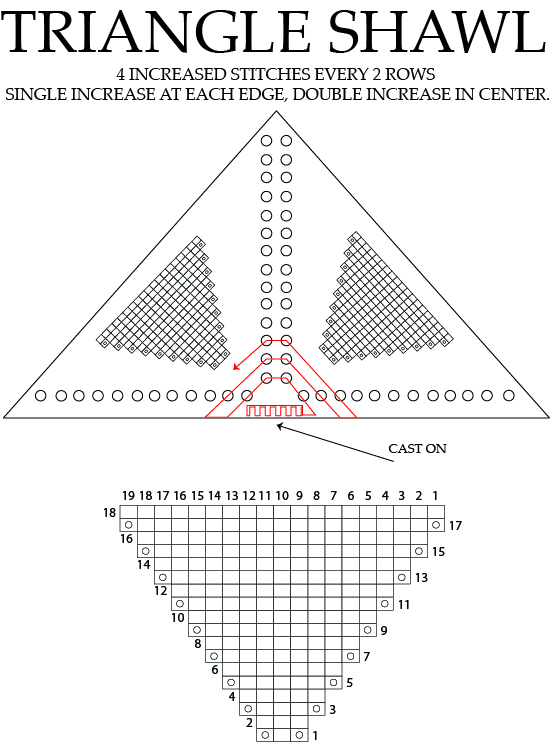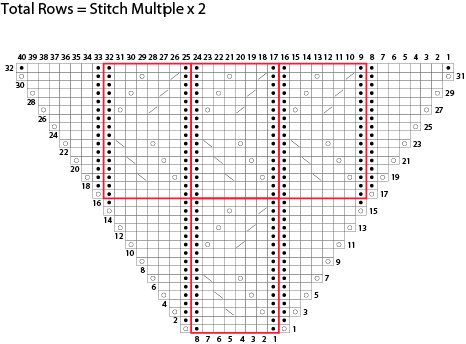
Triangle shawls are fun to knit! With 4 increases on every right side row, a triangle shawl is made of 2 pattern wedges, each of which have increases on either side every 2 rows. A center spine stitch is located between the wedges, and 2-3 edge stitches are worked on each side at the beginning and end of each row.
The basic pattern for this type of shaping involves working a small set of edge stitches (usually 2-3) garter stitches, working a section of the charted wedge shape, working a single center stitch, working a second charted wedge shape and finally working the remaining set of edge stitches.

Because triangle shawls are based on increasing one stitch on each side of each wedge every 2 rows this means that they increase the same number of stitches as the number of rows worked. For example if you are working 8 rows of a wedge shape you are increasing 2 stitches on each side of the right side rows 1, 3, 5, and 7, that means 4 right side rows multiplied by 2 increased stitches each row = 8 stitches. 8 rows and 8 stitches increased.
Choosing stitches for patterning on a triangle shawl follows the same rule, you need a stitch pattern that can create the same number of stitches as the number of rows the pattern takes to complete. By following this math your knitting pattern will have a repeatable chart that can be worked over and over to increase the size of your shawl.
What does this look like?
When looking through a stitch dictionary (or designing your own!) look for the magic ratios of:
Remember: Multiple is the word use to describe how many stitches are in a repeat of the stitch pattern.

Total Rows = Stitch Multiple
Example: 12 rows and 12 stitch multiple
If the number of rows for the pattern EQUALS the number of stitches in the multiple, then that pattern will make the number of stitches needed for a new repeat in the two repeats of a triangle shawl chart.
Each side of the chart increases 6 stitches in 12 rows, so you will need 2 repeats of the 12 rows, totaling 24 rows to increase 12 stitches on each side, making room for a full stitch multiple on each side. Each repeat is shown in a red box.

Total Rows = Stitch Multiple x2
Example: 16 rows and 8 stitch multiple
If the number of rows for the pattern IS TWICE the number of stitches in the repeat, then that pattern will make the number of stitches needed for a new repeat in the one repeat of a triangle shawl chart.
Each side of the chart increases 12 stitches in 24 rows, so you will need one repeat of the 24 rows to increase 12 stitches on each side making room for a full stitch multiple on each side. Each repeat is shown in a red box.

Total Rows = Stitch Multiple / 2
Example: 6 rows and 12 stitch multiple
If the number of rows for the pattern is HALF the number of stitches in the repeat, then that pattern will make the number of stitches needed for a new repeat in four repeats of a triangle shawl chart.
Each side of the chart increases 3 stitches in 6 rows, so you will need 4 repeats of the 6 rows, totaling 24 rows to increase 12 stitches on each side making room for a full stitch multiple on each side. Each repeat is shown in a red box.
This is a simple way to identify whether a stitch pattern has the right combination of numbers to be worked easily as a triangle shawl.
Remember that you can always insert an additional purl column in to a cable pattern, or maybe add 2 more rows of patterning to your desired stitch pattern to manipulate the numbers and make them easier to create a triangle shawl out of.


Thanks for sharing! I love to create my own design and this math tip really helps with pattern choices! My math teachers would be proud! 🥰
Thank you for sharing the triangle designs. I haven’t made one in years and have forgotten how.
Do you have suggestions for finishing a shawl edges? A few rows of lace or something?
Thank you for making this easy! I have been wanting to try knitting a shawl but was a little overwhelmed until now!
Very good instructions. I would be interested in making this shawl. Is the pattern available for free?
looks interedting
I like knitting and want some new ideas
I need the directions written and I’d follow. I too am visual. Thanks
free patterns! Thanks
Looks like fun